A mortise is the backbone of sturdy furniture construction. This rectangular recess is cut into wood to receive a tenon, and knowing how to cut one is an essential woodworking skill. Using a drill is an easy way to create these foundational joints, especially when making hinge mortises.
In this guide, we’ll walk you through how to cut mortises with a drill and provide expert tips and tricks.
Step-By-Step Guide To Cutting a Mortise
Creating hinge mortises doesn’t have to be time-consuming or difficult. By combining a Forstner bit with a cordless drill, you can create clean, professional-looking mortises with minimal effort. This five-step method requires minimal chiseling, making it convenient for woodworkers of all skill levels.
Practice and Preparation
A bit diameter that’s about two-thirds the width of the mortise strikes the perfect balance between speed and precision. We recommend practicing on scrap wood beforehand and taking the time to score your pencil lines accurately. These simple preparatory steps will noticeably improve the cleanliness and accuracy of your mortises.
Once you have the technique down, you’re ready to start cutting your mortises. Here’s how.
Step 1: Mark the Hinge Outline
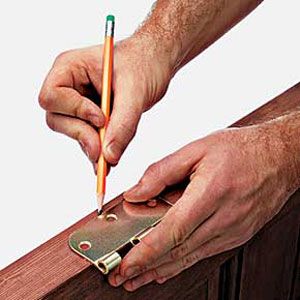
The first step in cutting a mortise with a drill is to mark the hinge outline accurately.
Begin by positioning the hinge on the edge of the door, making sure the knuckles are pointing in the direction the door opens. Use a sharp pencil to trace around the perimeter of the hinge, creating a clear outline. To improve the visibility and accuracy of your markings, score the pencil line deeply with a sharp utility knife. This scoring not only makes the outline more visible but also helps prevent wood fibers from tearing when you begin drilling.
Confirm that you’ve correctly aligned the hinge before moving on to the next step to achieve perfect placement.
Step 2: Mark the Mortise Depth
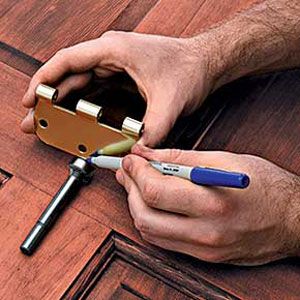
Accurately marking the mortise depth ensures a flush fit.
Hold the edge of the hinge against the lower edge of the Forstner bit. Take a felt-tip marker and, using the edge of the hinge as a guide, make a clear mark on the bit. This mark will serve as a visual indicator of how deep to drill. For added precision, repeat this process on the opposite spur of the bit. Having depth marks on both sides of the bit makes it so you can easily see the indicator regardless of the drill’s orientation during use.
Be thorough in marking both sides to avoid unintentional unevenness during the drilling process.
Step 3: Drill the Mortise
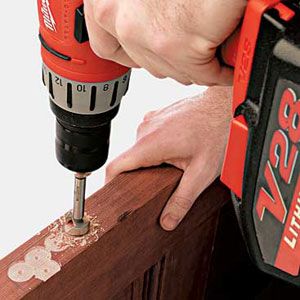
Drilling the mortise requires patience and precision.
Begin by positioning the Forstner bit square to the edge of the door, just inside the hinge outline you marked earlier. Start drilling slowly, maintaining a steady hand and consistent pressure. Continue until the depth line you marked on the bit reaches the surface of the door. Stop drilling and reposition the bit in an adjacent spot, slightly overlapping the previous hole. Work methodically across and along the length of the mortise, always keeping part of the bit next to an untouched surface. This untouched surface serves as a reference point, helping you maintain consistent depth throughout the mortise.
Consistency and steady pressure are key to avoiding over-drilling or creating an uneven surface.
Step 4: Trim the Waste
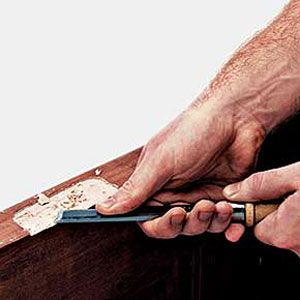
After drilling, you’ll likely have some waste material that the bit couldn’t reach, particularly in the corners.
To clean this up, use a sharp chisel. Hold the chisel with the bevel side up, placing one hand on the blade for control and the other on the handle for power. Starting from the knuckle side of the mortise, carefully slice away any remaining wood until the mortise floor is completely flat. Take care not to remove too much material, as this could affect the fit of the hinge.
Patience when trimming the waste helps the hinge fit perfectly, and the mortise remains neat and professional-looking.
Step 5: Test the Fit
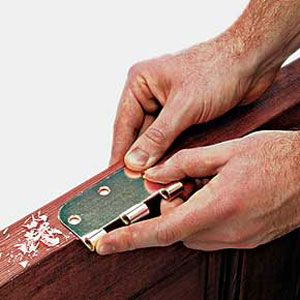
The final step is to test the fit of the hinge in the newly cut mortise.
Place the hinge in its mortise and check if it sits flush with the door surface. If the hinge protrudes at all, you’ll need to remove more material. You can do this by either drilling a bit deeper or using your chisel to carefully remove small amounts of wood until the hinge sits perfectly flush. Once you’ve achieved a perfect fit, you can proceed to fasten the hinge and move on to the next one if necessary.
By testing the fit multiple times, you significantly reduce the likelihood that you’ll have to make further adjustments after fastening the hinge.
Additional Tips for Cutting Precise Mortises
To make your mortises precise and professional-looking, follow these additional tips:
- Check alignment frequently: Continuously check that your hinge aligns correctly with its mark. Misalignment can cause the entire process to go off track.
- Create a template: If you’re making multiple identical mortises, create a template from a piece of scrap wood. This will speed up the marking process and provide consistency across all your mortises.
- Keep your bits sharp: Dull bits can lead to tear-out and inaccurate cuts. Regularly sharpen or replace your Forstner bits for clean, precise mortises.
- Maintain consistent speed: Fluctuating speeds can lead to uneven cuts and splintering of wood. A steady, consistent speed provides uniform depth and clean edges.
- Practice on scrap wood: Before tackling your actual project, practice the technique on some scrap wood. This will help you get a feel for the process and allow you to make mistakes without consequences.
- Use a backing board: To prevent tear-out on the back side of your workpiece, clamp a piece of scrap wood behind it before drilling.
- Use a drill press: For even more accuracy, use a drill press instead of a handheld drill. This will make sure your holes are perfectly perpendicular to the work surface.
Choosing the Right Forstner Bit To Cut Mortises
Selecting the appropriate Forstner bit is crucial for a successful result. Here are some factors to think about:
- Bit set: Purchase a set of Forstner bits in various sizes for versatility in future projects.
- Bit sharpness: Regularly check the sharpness of your Forstner bits. Dull bits can cause rough finishes and may compromise the precision of your mortises.
- Brand quality: Invest in reputable brands known for producing high-quality woodworking tools.
- Material: High-speed steel (HSS) bits are suitable for most woodworking tasks, but carbide-tipped bits offer superior durability for frequent use.
- Shank type: Check that the bit’s shank is compatible with your drill or drill press chuck.
- Size: Choose a bit that’s about two-thirds the width of your desired mortise. This allows for efficient drilling while leaving enough material for fine-tuning with a chisel.

